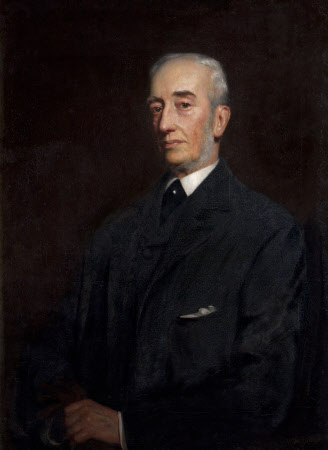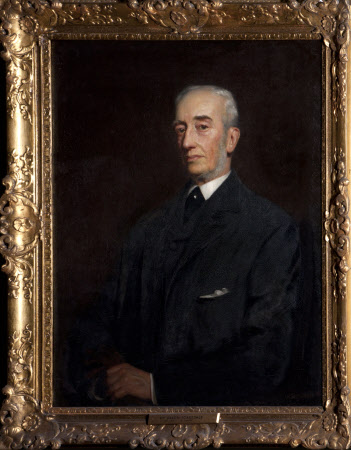The Reverend Alfred Nathaniel Holden Curzon, 4th Baron Scarsdale (1831-1916)
William Logsdail (Lincoln 1859 – Noke, Oxfordshire 1944)
Category
Art / Oil paintings
Date
1909 (signed and dated)
Materials
Oil on canvas
Measurements
864 x 698 mm (34 x 27 ½ in)
Place of origin
England
Order this imageCollection
Kedleston Hall, Derbyshire
NT 108824
Summary
Oil painting on canvas, The Reverend Alfred Nathaniel Holden Curzon, 4th Baron Scarsdale (1831-1916) by William Logsdail (Lincoln 1859 – Noke, Oxfordshire 1944), signed and dated, bottom right: William Logsdail, 1909. A half-length portrait, seated turned slightly to the left, gazing at the spectator, wearing a dark suit, and waistcoat, white shirt and dark tie, holding his gloves. Rector of Kedleston and father of Lord Curzon. Alfred’s youngest son, another Alfred, followed his father [Rev.and Hon. Alfred Curzon (1801-50)] into the church and would probably have spent the rest of his life as a Derbyshire vicar, if it had not been for a rapid succession of deaths: his father in 1850; his elder brother, after falling from a horse in Rotten Row, in 1855; and the 3rd Baron in 1856, unmarried. The Reverend Alfred Curzon was now the 4th Lord Scarsdale, but for the rest of his long life he retained the frugal habits of a shy country parson, adorned in long-side whiskers and billycock hat. The 4th Baron’s son Assheton described life in mid-Victorian Kedleston: "When my father married in 1856, they lived in the family wing on the first floor. The north-west corner being their breakfast room – the next room facing my mother’s sitting room leading to their bedroom. My father used the corner room facing south as his dressing room and the next room facing south as his writing and sitting room. The floor above was used as nurseries north and south. Lord Scarsdale hated spending money on himself, and showed no enthusiasm for modernising the central block at Kedleston. ‘He looks on the dilapidatd rooms with grim satisfaction,’ wrote his daughter-in-law, who called him ‘an old despot of the 13th century’: ‘He has 18 thermometers in his sitting-room, and the tables are covered with magazines and railway guides and almanacs of 1839, all covered with dust’ (she was writing in the 1890s). But Lord Scarsdale was very conscientious in maintaining the cottages on the estate, and was one of the first country-house owners to install electricity and baths with running water. Nor did the state rooms stay fossilised in their 18th century arrangement. Photographs from the 1890s show them crammed with easy chairs and occasional tables, so that people could talk in small groups, read, or write letters in comfort and privacy. Most of this furniture has since gone." By his careful economy, the 4th Lord Scarsdale restored the family finances, leaving an estate worth £450,000 in 1916 to his son, the most famous of all the Curzons.
Provenance
Bought with part of the contents of Kedleston with the aid of the National Heritage Memorial Fund in 1987 when the house and park were given to the National Trust by Francis Curzon, 3rd Viscount Scarsdale (1924-2000)
Credit line
Kedleston Hall, The Scarsdale Collection (acquired with the help of the National Heritage Memorial Fund and transferred to The National Trust in 1987)
Marks and inscriptions
W. Logsdail 1916 (artist's signature,painted, bottom rhs of canvas, black text)
Makers and roles
William Logsdail (Lincoln 1859 – Noke, Oxfordshire 1944), artist

